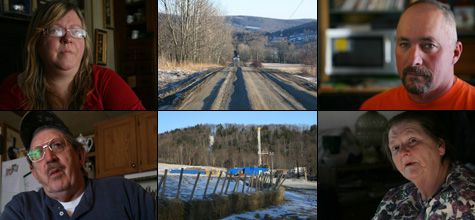This article was written by ProPublica’s Abrahm Lustgarten.
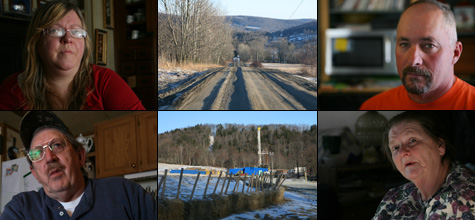 Pat Farnelli, top left, Ronald Carter, bottom left, Richard Seymour, top right, and Norma Fiorentino, bottom right, live in Dimock, Pa. A year after Cabot Oil & Gas landmen knocked on their doors to sign drilling leases, they are finding that their drinking water now contains methane, the largest component of natural gas. Abrahm Lustgarten / ProPublicaNorma Fiorentino’s drinking water well was a time bomb. For weeks, workers in her small northeastern Pennsylvania town had been plumbing natural gas deposits from a drilling rig a few hundred yards away. They cracked the earth and pumped in fluids to force the gas out. Somehow, stray gas worked into tiny crevasses in the rock, leaking upward into the aquifer and slipping quietly into Fiorentino’s well. Then, according to the state’s working theory, a motorized pump turned on in her well house, flicked a spark and caused a New Year’s morning blast that tossed aside a concrete slab weighing several thousand-pounds.
Pat Farnelli, top left, Ronald Carter, bottom left, Richard Seymour, top right, and Norma Fiorentino, bottom right, live in Dimock, Pa. A year after Cabot Oil & Gas landmen knocked on their doors to sign drilling leases, they are finding that their drinking water now contains methane, the largest component of natural gas. Abrahm Lustgarten / ProPublicaNorma Fiorentino’s drinking water well was a time bomb. For weeks, workers in her small northeastern Pennsylvania town had been plumbing natural gas deposits from a drilling rig a few hundred yards away. They cracked the earth and pumped in fluids to force the gas out. Somehow, stray gas worked into tiny crevasses in the rock, leaking upward into the aquifer and slipping quietly into Fiorentino’s well. Then, according to the state’s working theory, a motorized pump turned on in her well house, flicked a spark and caused a New Year’s morning blast that tossed aside a concrete slab weighing several thousand-pounds.
Fiorentino wasn’t home at the time, so it’s difficult to know exactly what happened. But afterward state officials found methane, the largest component of natural gas, in her drinking water. If the fumes that built up in her well house had collected in her basement, the explosion could have killed her.
Dimock, the poverty-stricken enclave where Fiorentino lives, is ground zero for drilling the Marcellus Shale, a prized deposit of natural gas that is increasingly touted as one of the country’s most abundant and cleanest alternatives to oil. The drilling here — as in other parts of the nation — is supposed to be a boon, bringing much-needed jobs and millions of dollars in royalties to cash-strapped homeowners.
But a string of documented cases of gas escaping into drinking water — not just in Pennsylvania but across North America — is raising new concerns about the hidden costs of this economic tide and strengthening arguments across the country that drilling can put drinking water at risk.
Near Cleveland, Ohio, an entire house exploded in late 2007 after gas seeped into its water well. The Ohio Department of Natural Resources later issued a 153-page report (PDF) that blamed a nearby gas well’s faulty concrete casing and hydraulic fracturing — a deep-drilling process that shoots millions of gallons of water, sand and chemicals into the ground under explosive pressure — for pushing methane into an aquifer and causing the explosion.
In Dimock several drinking water wells have exploded and nine others were found with so much gas that one homeowner was told to open a window if he planned to take a bath. Dishes showed metallic streaks that couldn’t be washed off and tests also showed high amounts of aluminum and iron, prompting fears that drilling fluids might be contaminating the water along with the gas. In February the Pennsylvania Department of Environmental Protection charged Cabot Oil & Gas with two violations that it says caused the contamination, theorizing that gas leaked from the well casing into fractures underground.
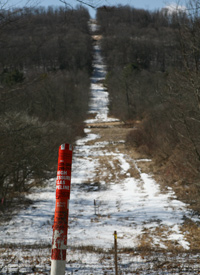 An underground gas line in Dimock, Pa. (Abrahm Lustgarten/ProPublica)Industry representatives say methane contamination incidents are statistically insignificant, considering that 452,000 wells produced gas in the United States last year. They also point out that methane doesn’t necessarily come from gas wells — it’s common in nature and can leak into water from biological processes near the surface, like rotting plants.
An underground gas line in Dimock, Pa. (Abrahm Lustgarten/ProPublica)Industry representatives say methane contamination incidents are statistically insignificant, considering that 452,000 wells produced gas in the United States last year. They also point out that methane doesn’t necessarily come from gas wells — it’s common in nature and can leak into water from biological processes near the surface, like rotting plants.
The industry also defends its construction technology, saying it keeps gas and drilling fluids — including any chemicals used for hydraulic fracturing — safely trapped in layers of steel and concrete. Even if some escapes, they say, thousands of feet of rock make it almost impossible for it to migrate into drinking water aquifers. When an accident happens, the blame can usually be traced to a lone bad apple — some contractor who didn’t follow regulations, they say. Those arguments helped the gas drilling industry win rare exemptions from the Safe Drinking Water Act and the Clean Water Act when Congress enacted the 2005 Energy Policy Act.
But now an exhaustive examination of the methane problem in western Colorado is offering a strong scientific repudiation of that argument. Released in December by Garfield County, one of the most intensely drilled areas in the nation, the report concludes that gas drilling has degraded water in dozens of water wells (PDF).
The three-year study used sophisticated scientific techniques to match methane from water to the same rock layer where gas companies are drilling — a mile and a half underground. The scientists didn’t determine which gas wells caused the problem or say exactly how the gas reached the water, but they indicated with more clarity than ever before that a system of interconnected natural fractures and faults could stretch from deep underground gas layers to the surface. They called for more research into how the industry’s practice of forcefully fracturing those deep layers might increase the risk of contaminants making their way up into an aquifer.
“It challenges the view that natural gas, and the suite of hydrocarbons that exist around it, is isolated from water supplies by its extreme depth,” said Judith Jordan, the oil and gas liaison for Garfield County who has worked as a hydrogeologist with DuPont and as a lawyer with Pennsylvania’s Department of Environmental Protection. “It is highly unlikely that methane would have migrated through natural faults and fractures and coincidentally arrived in domestic wells at the same time oil and gas development started, after having been down there …for over 65 million years.”
The Garfield County analysis comes as Congress considers legislation that would toughen environmental oversight of drilling and reverse the exemptions enjoyed by the gas companies. Colorado has already overhauled its own oil and gas regulations, despite stiff resistance from the energy industry. The new rules, which went into effect earlier this month, strengthen protections against, among other things, methane contamination.
Drinking water with methane, the largest component of natural gas, isn’t necessarily harmful. The gas itself isn’t toxic — the Environmental Protection Agency doesn’t even regulate it — and it escapes from water quickly, like bubbles in a soda.
But the gas becomes dangerous when it evaporates out of the water and into peoples’ homes, where it can become flammable. It can also suffocate those who breathe it. According to the Agency for Toxic Substances and Disease Registry, a part of the U.S. Department of Health and Human Services, as the concentration of gas increases it can cause headaches, then nausea, brain damage and eventually death.
Under Pressure
The carefully documented accident in Ohio in December 2007 offers a step-by-step example of what can happen when drilling goes wrong.
A spark ignited the natural gas that had collected in the basement of Richard and Thelma Payne’s suburban Cleveland home, shattering windows, blowing doors 20 feet from their hinges and igniting a small fire in a violent flash. The Paynes were jolted out of bed, and their house lifted clear off the ground.
Fearing another explosion, firefighters evacuated 19 homes in the small town of Bainbridge. Somehow, gas had seeped into the drinking water aquifer and then migrated up through the plumbing.
Gas had shown up in water in this part of Ohio in the past. In 2003 the U.S. Department of Health and Human Services investigated nearby residents’ complaints of “dizziness,” “blacking out,” “rashes,” “swelling of legs” and “elevated blood pressure” related to exposure to methane through bathing, dishwashing and drinking. That study concluded that gas in the area could migrate through underground fractures and said that “combustible gases, including methane, in private well water present an urgent public health hazard.”
According to Scott Kell, deputy chief of Ohio’s Division of Natural Resources, those earlier instances were determined to have had nothing to do with drilling activity. But by the time the Paynes’ house exploded four years later, the Natural Resources Department had begun to aggressively monitor for gas and this time it suspected a clearer link to drilling: It all had to do with how a well is constructed.
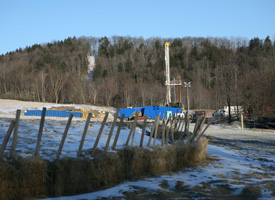 Called GEsford 3, this well is adjacent to Dimock resident Pat Farnelli’s house. There have been complications in drilling that well, including a drill bit that clogged the well for weeks, forcing them to have to drill a new hole. That is one of the possible causes being considered for the contamination in Farnell’s drinking water. (Abrahm Lustgarten/ProPublica)To reach natural gas, a well bore is drilled into the earth through dozens of geologic formations stacked like layers in a cake, until the bore reaches the layer holding gas. In Ohio, gas is produced from almost 3,700 feet, or three-quarters of a mile, below. In Colorado or Pennsylvania, wells can be a mile or two deep — far below drinking water aquifers.
Called GEsford 3, this well is adjacent to Dimock resident Pat Farnelli’s house. There have been complications in drilling that well, including a drill bit that clogged the well for weeks, forcing them to have to drill a new hole. That is one of the possible causes being considered for the contamination in Farnell’s drinking water. (Abrahm Lustgarten/ProPublica)To reach natural gas, a well bore is drilled into the earth through dozens of geologic formations stacked like layers in a cake, until the bore reaches the layer holding gas. In Ohio, gas is produced from almost 3,700 feet, or three-quarters of a mile, below. In Colorado or Pennsylvania, wells can be a mile or two deep — far below drinking water aquifers.
In many geologic regions, the deeper gas-bearing layers are under extraordinary pressure from the weight of earth and water above, but that pressure normally is contained by thousands of feet of leak proof rock that separate the gas from the surface. When a drill bit sinks down, though, the tight seal of each geologic layer is broken and the pressure is released, forcing water, gas or oil into the newly opened pathway. That’s how an oil well can become a gushing geyser.
To keep the gas and drilling fluids from leaking into the natural environment, drilling companies insert as many as three concentric rings of steel pipes inside the well bore to isolate what flows through them. When the bore passes through areas where extra protection is needed — such as drinking water aquifers — concrete is pumped into the gap between the rings of pipe to ensure an impenetrable seal. Most states, including Ohio, require these measures in part to protect drinking water.
“That’s pretty much the holy grail, good and proper cementing and casing,” said Michael Nickolaus, former director of Indiana’s Department of Natural Resources, Oil and Gas Division and special projects director for the Ground Water Protection Council, a group of scientists and state regulators that studies industries’ impacts on water. Nickolaus added that if these zones are properly isolated from one another, the issue of groundwater contamination, whether from gas or hydraulic fracturing, goes away.
The investigation into the explosion at the Paynes’ home found that a drilling company working nearby had failed to properly build that protective concrete casing and had continued to process the well despite warning signs that should have alerted it to stop. Six weeks before the explosion, the company, Ohio Valley Energy Systems, pumped concrete into the well casing. But it couldn’t fill the gap, evidence that somewhere a crack was allowing the concrete to seep into the space between the pipes, and probably out into the surrounding earth.
If the concrete could leak, then so could drilling fluids — or the gas itself.
A week later, “despite the fact that the cement behind the casing was insufficient by standard industry practice,” according to the state’s report (PDF), the company began hydraulic fracturing. More than 46,000 gallons of water, sand and chemicals were pumped into the well bore with enough force to crack the rock and release the gas.
Again, the drillers saw signs of a leak in the well. The company tried to recover as much of the leaking fluid as possible, but the state report said at least 1,000 gallons of fracturing fluid, including about 150 gallons of oil, disappeared into the space between the well pipes and possibly out into the ground.
Finally, the company shut down the well. But the underlying pressurized gas formation had already been punctured, and its contents were trying to escape. The gas collected inside the well for the next 31 days, until 360 pounds of pressure built against the valve at the top. It was enough, state investigators wrote, to force the gas out of the well bore by any means it could find.
“This overpressurized condition resulted in invasion of natural gas from the annulus of the well into natural fractures in the bedrock below the base of the cemented surface casing,” the report states, adding that it was the first time anything like this had been confirmed in Ohio.
Ohio Valley Energy Systems did not return calls for comment on the state’s findings.
On Dec. 12, three days before the Paynes’ house exploded, methane was detected in the Bainbridge Police Department’s water well, 4,700 feet from the gas well in question. Two days later nearby residents reported sediment in their water and artesian conditions in their wells, meaning the water was spurting out under pressure. By the next morning the gas — still seeking an outlet — had forced its way into Richard Payne’s basement, where it reached a flammable concentration. All it needed was a spark.
Science Blames Drilling
 Dimock resident Norma Fiorentino’s drinking water well was a time bomb. On New Year’s morning, her well exploded. After the blast, state officials found methane in her drinking water. (Abrahm Lustgarten/ProPublica)As regulators in Ohio struggled to reconcile what was happening there, officials in Garfield County, Colo., were waiting for the results of the three-part, three-year study examining the connections between methane leaks and drilling there.
Dimock resident Norma Fiorentino’s drinking water well was a time bomb. On New Year’s morning, her well exploded. After the blast, state officials found methane in her drinking water. (Abrahm Lustgarten/ProPublica)As regulators in Ohio struggled to reconcile what was happening there, officials in Garfield County, Colo., were waiting for the results of the three-part, three-year study examining the connections between methane leaks and drilling there.
The report is significant because it is among the first to broadly analyze the ability of contaminants to migrate underground in drilling areas, and to find that such contamination was in fact occurring. It examined over 700 methane samples from 292 locations and found that methane, as well as wastewater from the drilling, was making its way into drinking water not as a result of a single accident but on a broader basis.
As the number of gas wells in the area increased from 200 to 1,300 in this decade, the methane levels in nearby water wells increased too. The study found that natural faults and fractures exist in underground formations in Colorado, and that it may be possible for contaminants to travel through them.
Conditions that could be responsible include “vertical upward flow” “along natural open-fracture pathways or pathways such as well-bores or hydraulically-opened fractures,” states the section of the report done by S.S. Papadopulos and Associates (PDF), a Maryland-based environmental engineering firm specializing in groundwater hydrology.
The researchers did not conclude that gas and fluids were migrating directly from the deep pockets of gas the industry was extracting. In fact, they said it was more likely that the gas originated from a weakness somewhere along the well’s structure. But the discovery of so much natural fracturing, combined with fractures made by the drilling process, raises questions about how all those cracks interact with the well bore and whether they could be exacerbating the groundwater contamination.
“One thing that is most striking is in the area where there are large vertical faults you see a much higher instance of water wells being affected,” said Geoffrey Thyne, the hydrogeologist who wrote the report’s summary and conclusion (PDF). He is a senior research scientist at the University of Wyoming’s Enhanced Oil Recovery Institute, a pro-extraction group dedicated to tapping into hard-to-reach energy reserves.
The report, referred to as the Garfield County Hydrogeologic Study, has been met with cautious silence by the industry and by its regulators.
The Colorado Oil and Gas Conservation Commission, the state’s regulatory body, would not respond to questions from ProPublica because it hasn’t thoroughly analyzed the data behind the December report, said its director, David Neslin.
Neither the Colorado Oil and Gas Association nor Encana, the Canadian energy company that drills in the study area, would comment on the Garfield County report. Both referred questions to Anthony Gorody, a Houston-based geochemist who specializes in oil and gas issues and frequently is employed by the energy industry.
Gorody dismissed the report’s conclusions as “junk science.”
“This is so out of whack. There are a handful of wells that have problems. These are rare events,” said Gorody, president of Universal Geosciences Consulting. “They are like plane crashes — the extent tends to be fairly limited. I do not see any pervasive impact.”
Most of the methane in the study area, Gorody said, came from decaying matter near the surface — not from the deep gas produced by the energy industry. He criticized the report’s methodology, saying the way that researchers linked the stray gas with the deep gas formations was speculative at best.
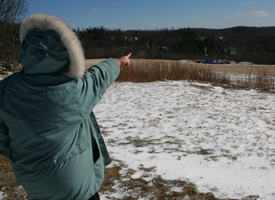 To Dimock resident Pat Farnelli, seen here pointing to the drilling rig in her backyard, the promise of making money off her family’s land came at just the right time. But perhaps not at the right price. Now she spends more than $100 of her monthly food stamp allotment to buy plastic jugs of drinking water. (Abrahm Lustgarten/ProPublica) Thyne, standing by his report, said researchers had traced the origin of the gas by conducting the equivalent of a forensic investigation, analyzing its isotopic signature, or molecular fingerprint. The molecular structure showed that most of it was thermogenic, meaning it matched the deeply buried deposit where gas was being drilled, called the Williams Fork Formation. A minority of the samples were difficult to identify by this method, so Thyne used another scientific process to study them. He is confident they, too, were thermogenic in origin.
To Dimock resident Pat Farnelli, seen here pointing to the drilling rig in her backyard, the promise of making money off her family’s land came at just the right time. But perhaps not at the right price. Now she spends more than $100 of her monthly food stamp allotment to buy plastic jugs of drinking water. (Abrahm Lustgarten/ProPublica) Thyne, standing by his report, said researchers had traced the origin of the gas by conducting the equivalent of a forensic investigation, analyzing its isotopic signature, or molecular fingerprint. The molecular structure showed that most of it was thermogenic, meaning it matched the deeply buried deposit where gas was being drilled, called the Williams Fork Formation. A minority of the samples were difficult to identify by this method, so Thyne used another scientific process to study them. He is confident they, too, were thermogenic in origin.
In most cases, the study couldn’t pinpoint the exact pathway the contaminants had used to travel a mile and a half up into the drinking water aquifer. So Thyne could only reason the possibilities.
The methane could be seeping into water wells through natural fractures, he said, or through leaks in the well casings or concrete, or from the well heads.
When a pipe extends 8,000 feet below the earth’s surface, he said, “there are numerous potential leak points along the way. So is it leaking at 8,000 feet and coming up a well bore, a natural fault or fracture? Or is it leaking 500 feet from the surface? We don’t know.”
The most plausible explanation, Thyne said, is that the same type of well casing and cementing issues that had proved problematic in Ohio were presenting problems in Colorado too.
“The thesis is that because of the way the wells are designed they could be a conduit,” said Garfield County’s Jordan, who commissioned the report.
Jordan worries that the methane leaks could be a sign of worse to come.
“We suspect the methane would be the most mobile constituent that would come out of the gas fields. Our concern is that it’s a sort of sentinel, and there are going to be worse contaminants behind it,” she said. “It’s not just sitting down there as pure CH4 (methane). It’s in a whole bath of hydrocarbons,” she said, and some of those “can be problematic.”
‘You Can’t Buy a Good Well’
When landmen from Cabot Oil & Gas came knocking on doors along the rutted dirt grade of Carter Road in Dimock, Pa., last year they sold a promise many residents in the farming community were eager to hear: Sign a gas lease and the land might finally pay for itself.
Many of Dimock’s 1,300 residents had fallen on hard times. Approximately one in seven were out of work, and more than a few homes were perched on the precipice of foreclosure.
Cabot offered $25 an acre for the right to drill for five years, plus royalties when the gas started flowing. To outsiders it might seem a small amount, but it would make an immediate difference to people who owned fields but few other assets.
“It seemed like God’s provenance,” said Pat Farnelli, whose husband, a farmer, had taken a job as a night chef at a diner on the Interstate to pay one more month’s mortgage. The day Cabot’s man showed up — with a wide-brim hat and a Houston drawl — the Farnellis mistook him for a debt collector. “We really were having a rough time right then — that day. We thought it was salvation. Any ray of hope here is a big deal.”
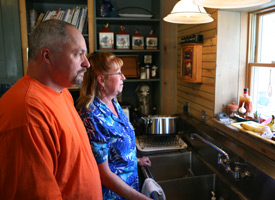 Richard Seymour, seen here with his wife Wendy, runs a certified natural farm that ships produce across the state. His well is now running red and turbid and bubbles with so much gas that he fears he’ll lose his agricultural certification. (Abrahm Lustgarten/ProPublica)That was more than a year ago, and since then Cabot — which earned close to a billion dollars in revenue last year — has drilled 20 wells and is producing $58 million worth of gas there annually. In its annual report Cabot bullishly called the Dimock field a once-in-a-lifetime “game changing event” (PDF) for the company and announced it would drill 63 more wells there next year.
Richard Seymour, seen here with his wife Wendy, runs a certified natural farm that ships produce across the state. His well is now running red and turbid and bubbles with so much gas that he fears he’ll lose his agricultural certification. (Abrahm Lustgarten/ProPublica)That was more than a year ago, and since then Cabot — which earned close to a billion dollars in revenue last year — has drilled 20 wells and is producing $58 million worth of gas there annually. In its annual report Cabot bullishly called the Dimock field a once-in-a-lifetime “game changing event” (PDF) for the company and announced it would drill 63 more wells there next year.
The wealth has begun trickling down to the residents of Dimock. A few will earn more than a half-million dollars this year, and bimonthly checks for $6,000 are not uncommon. Cabot and its contractors also support the local economy by hiring local labor and patronizing hotels and restaurants in nearby towns.
But the water contamination is forcing the people who live there to accept a difficult compromise.
“You have to evaluate which is more important, the money or the water,” said a Dimock resident who declined to be named because he doesn’t want to antagonize Cabot, which he says will pay him more than $600,000 this year for the wells on his property. “The economy is so tough. Suppose you could stop drilling — no one wants Cabot to go away.”
For some, though, the benefits can be easily erased.
Norma Fiorentino, whose well exploded on New Year’s morning, got just $97 in royalties in February. Now a part of her monthly $646 Social Security check goes to buy water. “You can’t buy a good well,” she said.
Down the road, Pat Farnelli spends more than $100 of her monthly food stamp allotment to buy plastic jugs of drinking water. Next door, Ronald Carter paid $7,000 to install two water treatment systems for his family, then learned they won’t remove the gas.
Cabot has begun voluntarily supplying water to at least five homes in Dimock, a gesture the company says does not mean it has acknowledged fault. “For now Cabot is simply trying to do the right thing while studies are being performed and data is being obtained,” said Kenneth Komoroski, Cabot’s spokesman.
Others have yet to get any aid.
“This isn’t something that people should be living with,” said Craig Lobins, the regional oil and gas manager for Pennsylvania’s Department of Environmental Protection. “It’s serious.”
Pennsylvania’s DEP places responsibility for the contamination squarely on Cabot.
In January the DEP blamed the company for polluting one water well. Then in late February it sent Cabot a list of violations (PDF) it said led to methane seepage in other area wells. Investigators think the seepage was caused by a weakness in the well casing or an improper cementing job, much like what had been reported in Colorado and Ohio. The good news was that they found no evidence that any of the hydraulic fracturing fluids had leaked into well water.
Komoroski, the Cabot spokesman, said it’s too early to conclude the company is responsible for contaminating Dimock’s wells.
He said Cabot has hired an expert who is still investigating exactly what happened in the case.
“The DEP’s letter was premature,” Komoroski said, “It is possible that Cabot is responsible. It’s possible it is not. That’s what we hired a hydrogeologist to help us determine.”
Cabot has since cemented the entire length of its well casings in Dimock — a safeguard similar to what has been prescribed in Ohio and Colorado — and believes that measure, which is more extensive than state regulations require, will solve the problem.
Yet the DEP sees no need to require such precautions at all the state’s wells, because what is happening in Dimock is “an anomaly.”
“Last year we permitted 8,000 wells, and this may be the only incident that occurred,” said the DEP’s Lobins. “You can’t cover every possible scenario that you could encounter out there, so when the regulations are crafted it addresses the ones that will be most protective of 99.9 percent of the wells.”
Industry spokesmen also oppose making the precautionary cementing practices mandatory.
“For one thing it is very costly,” said Lee Fuller, vice president of government relations at the Independent Petroleum Association of America. “At the same time if you try to put in too much cement you can risk collapsing the well. So it’s drawing a balance between protecting the groundwater” and “protecting the well that you are constructing.”
At the bottom of the hill on Carter Road, Richard Seymour runs a certified natural farm that ships produce across the state. His well is running red and turbid and bubbles with so much gas that he fears he’ll lose that agricultural certification. If there’s a technology, like cementing, that can protect his water, then shouldn’t it be required in every case, he asks?
“We feel pretty alone on this, pretty frustrated,” Seymour said. “I assumed the DEP, EPA, the state — the government — would protect our land. We didn’t know that as a landowner the burden was on us.”
